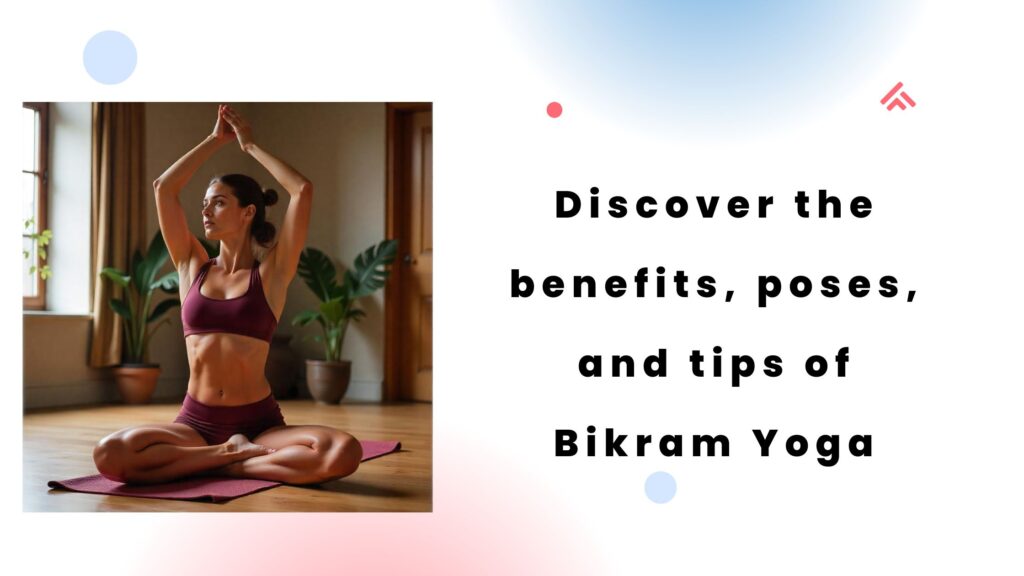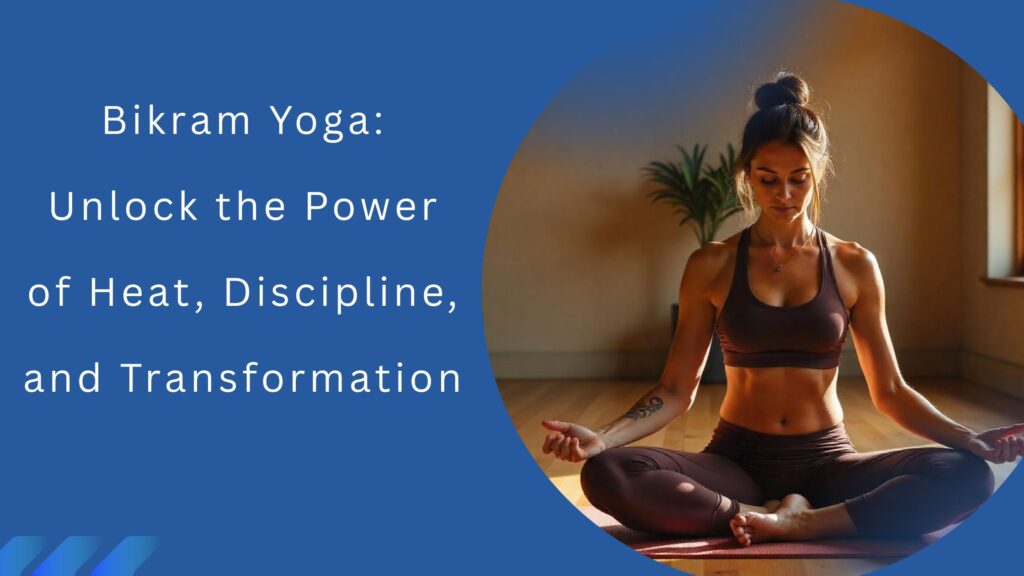Have you ever walked by a steamy yoga studio and wondered, “Why are people willingly exercising in a 105-degree room?” Welcome to the world of Bikram yoga, a practice that’s as intense as it is transformative. Whether you’re looking to increase flexibility, detox your body, or challenge your mental focus, Bikram yoga might just be the discipline you need.
In this comprehensive guide, we’ll explore what Bikram yoga is, its incredible benefits, what to expect in a class, and how it compares to other yoga styles.
Bikram Yoga, performed in a heated room, provides numerous benefits such as enhanced flexibility, better cardiovascular health, and detoxification through sweating. This practice features a fixed series of 26 postures and two breathing exercises, designed to test both the body and the mind.
Table of Contents
What Is Bikram Yoga?
Bikram yoga is a specific type of hot yoga developed by Bikram Choudhury in the 1970s. Unlike many yoga styles that vary by teacher or studio, Bikram yoga follows a strict sequence of 26 postures and 2 breathing exercises, practiced in a room heated to 105°F (40°C) with 40% humidity.
This fixed routine is designed to systematically work every part of your body- muscles, joints, organs, and even veins while flushing out toxins through intense sweating.
Bikram Yoga vs. Hot Yoga
While often used interchangeably, Bikram yoga and hot yoga are not the same. Hot yoga may vary in style, postures, or duration, but Bikram yoga always follows the same sequence, structure, and heat conditions. Think of Bikram as the original, highly disciplined form of hot yoga.
The Science Behind the Heat
Why practice in such high heat? It’s not just to make you sweat. The heat in Bikram yoga classes serves several specific purposes:
- Increased flexibility: Warmer muscles are more pliable, which allows for deeper stretching and reduced risk of injury.
- Improved circulation: The heat enhances blood flow, delivering more oxygen and nutrients to your organs and muscles.
- Detoxification: Sweating in a Bikram class helps release toxins stored in the body.
- Mental discipline: Staying focused and calm in a challenging environment strengthens your mental resilience.
Physical and Mental Benefits of Bikram Yoga
The benefits of Bikram yoga go well beyond just sweating and stretching. Let’s break them down:
1. Enhances Flexibility and Mobility
The heat helps your body stretch safely and effectively. Over time, you’ll notice improved range of motion in your hips, spine, shoulders, and hamstrings.
2. Builds Strength and Balance
Holding the 26 poses for a full 90 minutes challenges your muscles like no other. You’ll build strength in your core, legs, arms, and back—especially in poses like Awkward Pose and Balancing Stick.
3. Aids in Weight Loss
Many people turn to Bikram yoga for weight loss. A single session can burn 500–1,000 calories depending on your effort and body type. Combined with healthy habits, this makes it a powerful part of a fitness routine.
4. Improves Cardiovascular Health
The intensity of the practice raises your heart rate, improving blood flow and cardiovascular endurance over time.
5. Reduces Stress and Anxiety
The meditative aspect of repeating the same sequence creates a calming rhythm that helps relieve stress and encourages mindfulness. Many practitioners report feeling mentally “lighter” after class.
6. Strengthens Mental Focus and Discipline
Being in a hot room for 90 minutes with no distractions teaches you how to stay centered under pressure. That mental toughness can translate to every part of your life.
Read more: Yoga: A Timeless Path to Physical, Mental, and Spiritual Wellness
Read more: Hatha Yoga: The Ancient Path to Modern Wellness

What to Expect in a Bikram Yoga Class
If you’re new to Bikram yoga, it’s normal to feel intimidated. Here’s a walkthrough of what to expect in your first class:
Class Duration and Structure
Each Bikram yoga class is exactly 90 minutes long and follows the same sequence:
- 26 poses performed twice
- 2 breathing exercises (beginning and end)
- One short break in the middle
Studio Setup
The room is:
- Heated to 105°F (40°C)
- Carpeted to reduce injury risk
- Equipped with mirrors to monitor alignment
What to Wear
- Lightweight, moisture-wicking clothes (shorts, sports bras, tank tops)
- Avoid loose clothing—it traps heat and sweat
- Bring a yoga mat, towel, and plenty of water
First-Timer Tips
- Arrive early to acclimate to the heat
- Stay in the room even if you need to rest
- Hydrate before, during, and after class
- Don’t expect perfection—just progress
Potential Risks and Precautions
While Bikram yoga is beneficial for many, it’s not suitable for everyone. Here’s what you need to know:
Who Should Be Cautious?
- Pregnant individuals (unless cleared by a doctor)
- People with cardiovascular conditions
- Those with heat sensitivity or low blood pressure
Common Side Effects
- Dizziness or nausea (especially in early classes)
- Dehydration
- Light-headedness
Safety Tips
- Drink water throughout the day—not just during class
- Don’t eat a heavy meal beforehand
- Take breaks as needed
- Talk to your instructor about any health concerns
Bikram Yoga vs. Other Yoga Styles
Wondering how this yoga compares to Vinyasa, Hatha, or Ashtanga? Here’s a breakdown:
| Yoga Style | Heat Level | Structure | Intensity | Best For |
| Bikram | 105°F | Fixed sequence | High | Weight loss, discipline |
| Vinyasa | Optional | Variable flow | Medium-High | Cardio, creativity, movement |
| Hatha | No heat | Slower-paced | Low-Medium | Beginners, alignment focus |
| Ashtanga | No heat | Set but challenging | High | Strength, endurance, structure |
If you’re goal-oriented and enjoy routine, Bikram yoga might be the perfect fit. But if you prefer variety or less heat, another style may suit you better.
Controversies Around Bikram Yoga
It’s important to acknowledge the controversy surrounding Bikram Choudhury, the founder of this practice. He has faced multiple allegations of misconduct, which led to a decline in the use of his name in many studios.
What’s Changed?
- Many studios now offer “Bikram-style” classes without using the brand name
- The practice remains the same, minus the association with its controversial founder
Is Bikram Yoga Right for You?
Before you dive in, ask yourself:
- Do I enjoy intense, structured workouts?
- Am I comfortable working out in heat?
- Am I looking for a mental and physical challenge?
Ideal Candidates
- Athletes wanting increased flexibility
- People seeking stress relief
- Anyone looking to burn calories and tone muscles
- Those who love routine and structure
If these sound like you, Bikram yoga could be a game-changer.
Conclusion: Step Into the Heat, Step Into Your Power
Bikram yoga isn’t for the faint of heart—but it’s also not just for advanced yogis or fitness fanatics. It’s for anyone ready to test their limits, build strength from the inside out, and embrace discomfort as a path to growth.
By practicing in the heat, you not only transform your body—you train your mind to stay calm in chaos, focused under pressure, and consistent in challenge. Whether you’re looking for yoga for flexibility, mental clarity, or a serious calorie burn, Bikram yoga offers it all.
So why not take the leap? Find a local class, bring your mat and towel, and sweat your way to a stronger you.
FAQ:
Q. Is Bikram yoga good for beginners?
Ans: Yes, Bikram yoga can be suitable for beginners, especially those who appreciate structure and routine. Since each class follows the same 26 postures and 2 breathing exercises, it’s easy to track progress over time. However, the heat and intensity may feel overwhelming at first. New students are encouraged to rest when needed and stay hydrated. Starting slow and staying consistent is key to success in beginner Bikram yoga.
Q. How many calories can you burn in a Bikram yoga class?
Ans: A 90-minute Bikram yoga class can burn anywhere between 500 to 1,000 calories, depending on your body type, fitness level, and effort. The combination of high heat, challenging postures, and constant movement increases heart rate and promotes fat burn. It’s one reason why many people turn to Bikram yoga for weight loss.
Q. What should I wear to a Bikram yoga class?
Ans: Wear lightweight, moisture-wicking clothing that allows your skin to breathe. Most people opt for shorts, tank tops, or sports bras. Avoid heavy or loose fabrics—they’ll trap sweat and make you more uncomfortable. Also, bring a yoga mat, a large towel to place over the mat, and a water bottle to stay hydrated throughout the session.
Q. Is Bikram yoga safe to do every day?
Ans: While some experienced practitioners do Bikram yoga daily, it’s important to listen to your body. The heat and intensity can be physically taxing, especially for beginners. Most people benefit from 2–4 sessions per week, with proper hydration and rest in between. If you experience dizziness, dehydration, or fatigue, it’s best to take a break and consult a healthcare provider.
Q. What’s the difference between Bikram yoga and hot yoga?
Ans: While both are practiced in heated rooms, Bikram yoga follows a strict format: 26 specific poses, 2 breathing exercises, a 90-minute duration, and a 105°F room with 40% humidity. In contrast, hot yoga can vary in style, temperature, and sequence. Not all hot yoga is Bikram yoga, but all Bikram yoga is technically hot yoga. If you’re looking for consistency and structure, Bikram yoga is the way to go.
Q. What is the purpose of Bikram yoga?
Ans: Bikram yoga was developed in the 1970s by Bikram Choudhury. It enhances the effects of traditional yoga by incorporating heat, which allows muscles to stretch more easily. The heated environment also promotes sweating, which is believed to aid in detoxification and weight loss.
Q. What are the principles of Bikram yoga?
Ans: Bikram Yoga is built on three core principles: mindful breathing, maintaining each posture, and experiencing deep relaxation. These elements combine to make the practice both physically demanding and mentally rejuvenating.
Q. Why is Bikram yoga so popular?
Ans: Though it might seem intense, Bikram yoga is known for its detoxifying effects while enhancing strength, flexibility, and mental and physical discipline.
Q. What is Bikram yoga called now?
Ans: Bikram Yoga is commonly known today as Original Hot Yoga or 26 & 2. This shift in terminology reflects a move away from the founder, Bikram Choudhury, due to various controversies. While “hot yoga” is a broader term, “Original Hot Yoga” or “26 & 2” specifically refer to the standardized sequence of 26 postures and 2 breathing exercises that define this style.
We use third-party videos and images on https://yogavidhi.com/ for educational and illustrative purposes. All rights belong to their respective owners. No copyright infringement is intended.



